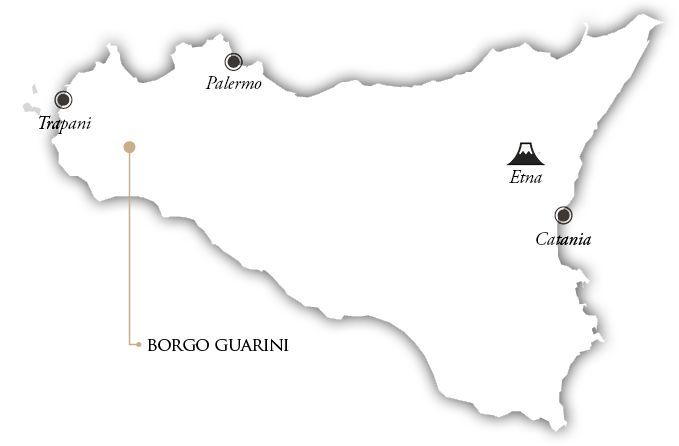The Mediterranean charm of Zibibbo
JASMIN
IGT Terre Siciliane
Zibibbo
Zibibbo is the aromatic variety also suitable for dry vinification with a bouquet that recalls the scents and scents of spring flowers and the savory marine notes coming from the sea. Jasmin is the perfect revelation of all this Mediterranean charm thanks to the particular climatic conditions found on the Borgo Guarini estate within a hillside Terroir and the Baglio Sorìa estate, influenced by the sea. The temperature variations between day and night favor the accumulation of the olfactory components, creating a fascinating suggestion with a strong style and exotic elegance. Jasmin is a wine that invites conviviality and the joy of being together. Jasmine, citrus fruit, mediterraneas fragrances characterize the unique and noble blend of Zibibbo grapes growing on the hill and by the sea.
Zibibbo is the aromatic variety also suitable for dry vinification with a bouquet that recalls the scents and scents of spring flowers and the savory marine notes coming from the sea. Jasmin is the perfect revelation of all this Mediterranean charm thanks to the particular climatic conditions found on the Borgo Guarini estate within a hillside Terroir and the Baglio Sorìa estate, influenced by the sea. The temperature variations between day and night favor the accumulation of the olfactory components, creating a fascinating suggestion with a strong style and exotic elegance. Jasmin is a wine that invites conviviality and the joy of being together. Jasmine, citrus fruit, mediterraneas fragrances characterize the unique and noble blend of Zibibbo grapes growing on the hill and by the sea.[/read]
- Appellation: IGT Terre Siciliane
- Vine: Zibibbo
- Terroir: hilly | sea
- Soil: mid-mixture, mostly clayey
- Exposure: west (300/400mt. a.s.l) | south/south-east (300/400mt. a.s.l)
Production Area
Borgo Guarini

The hilly structure of Borgo Guarini creates different soil climates depending on the altitude in which you are located. Moving from one hill to another varies not only the chemical composition of the soil but also the entire pedoclimatic context. The Baglio Sorìa estate is located a few kilometers from Trapani, in western Sicily, where the cultivation of vines requires that the plants are not excessively loaded, in order to obtain a higher quality of the fruit.

Jasmin
Fragrances, aromas and Sicilian freshness
The virtuous path followed by Firriato since its foundation to enhance native Sicilian vines achieves a step more with Jasmin, a zibibbo grape-based wine expressing the particular sensorial profile of this grape variety. Zibibbo grapes have been historically used to make sweet or sparkling wines but Firriato decided to vinify them to produce still wine enhancing its aromatic profile and making a very drinkable wine. Eclectic soils of the Borgo Guarini estate rich in sodium and clay are the cradle of this aromatic variety composing Jasmin. The natural property of this soil enables Firriato to exalt the variety characteristics expressing the most inner fragrances of orange peel and mature figs together with elegant jasmin notes which name this precious label.
JASMIN
The characteristics of vintages
2022
The 2022 vintage was the protagonist of an excellent harvest, from a qualitative and quantitative point of view thanks to the constant stability of temperatures and a winter that was not too harsh. During the winter there was no shortage of rain which contributed to making the soil softer and replenishing water resources.
2020
In the Trapani countryside and Calamoni di Favignana, 2020 grape harvest was generally affected by a variable climatic trend compared to 2019. Actually temperatures above the seasonal average – in particular between the months of January and February – and a certain drought from May to late September, influenced a lot of vine life cycle. These conditions slightly anticipated the budding phase, by reducing vine development and growth in the matter of foliage until flowering with a lower production yield (about 30%) – for white grape varieties in particular – in favor of quality: a of the best in recent years.
2019
Vintage 2019 was generally affected by the colder and rainier climatic trend compared to the averages of recent years. Temperatures were below the seasonal average during the flowering period and favorable climatic conditions were also recorded during ripening.
2018
After a winter and a spring with abundant rainfall, summer did not make the thermometers soar and the sugar level was lower than in 2017. September recorded a slight increase in moisture and minimum temperatures compared to last year, but without ever causing particular phytosanitary problems. At the beginning of the third part of the same month there were copious rains (on the 21st and the 22nd) that slowed down the harvest, but fortunately without compromising the health of the grapes.
2017
Mild winter with appropriate moderate rainfalls and mild spring eased the regular vegetative process of the vines. Fortunately the lacking of precipitations over the springtime and the heat wave of the first part of June did not make plants undergo water stress. Among July and August temperature reached very high level compared to typical seasonal average. Although this heat wave, the temperature fluctuations eased a good aromatic maturation of the grapes that had been harvested almost a week before but with a drop of production by 25%. Vintage 2017 climate conditions positively influenced native white grapes as the Zibibbo growing in the Borgo Guarini Estate and in the Calamoni di Favignana one. Broadly speaking grapes had been harvested in great conditions at the right sugar concentration level in both Firriato’s estates.
2016
The summer season 2016 has been characterised by mild cimate, few rainfalls without excessive heat. After a winter characterised by few rainfalls, spring season began with cool temperatures lasted over flowering until the months of May and June when spring concluded with some rainfalls.These climatic conditions fostered a great vine life-cycle in the vineyard.
2015
Very complex in terms of weather, the heat and rain Fall 2014 resulted in the appearance of a significantly reduced spontaneous sward and characterized by the presence of species microthermal (those that adapt and grow at low temperatures). In late they turn out to be the most wild and cultivated plants seed.
2014
It was an unforgettable vintage thanks largely to an almost uniform and very balanced climate, the spring was rightly rainy with cool summer which favoured ripening slow and gradual. There is talk of ” a summer without Scirocco wind”,” July is spent without excessive heat. Parallel there were recorded ^temperature day/night very marked^ in all companies Firriato which helped the development of aromas and flavours.
2013
The year showed to be fruitful. Either regarding the quantity, and definitely regarding the quality “very interesting wines regarding the aromatic profile” had been obtained. Because of the climate, the harvest lasted till the last week of September. The year 2013 gave a slower harvest and then a gradual maturation.
2012
The end of August was a decisive date for the manual harvest of grapes from the autochthonous Zibibbo vines on the Borgo Guarini estate, which reached full ripeness thanks to the favourable soil and climate conditions. 2012 saw a winter that was not too harsh, with scarce rainfall, a humid spring and a muggy and sunny summer.


JASMIN
Awards
2020
International Wine Report: 91 pts
2018
International Wine Report: 92 pts
2017
James Suckling: 92 pts
International Wine Report: 90 pts
Robert Parker: 86 pts
2016
The Tasting Panel: 91 pts
James Suckling: 92 pts
Vinous: 89 pts
2013
Luigi Veronelli: 2 red stars
2012
Annuario dei Migliori Vini d’Italia: 88 pts
Bibenda: 4 green clusters
Paired with
Two Seas Couscous
“Rolling” of the semolina grains. Take about a third of the semolina and pour it into a mixing bowl big enough to easily hold the whole 500g plus water for working the grains; Mix together with your fingers using a circular motion, starting to add the water a little at a time mixing as you go. The grains of semolina puff up as they absorb the water, and being rolled around by your fingers they start clumping together to form tiny balls. Continue mixing.

















